So you finally found the perfect candidate for that vacant position at your company. Congratulations! These days quality hires are getting more difficult to come by, as well as retain, beyond the employee onboarding period.
That’s why it’s important to wow your new employees from the very beginning, and an expertly crafted welcome-to-the-team email is a good place to start.
In this article, we’re examining the process of drafting the perfect welcome email, so keep reading and find out how to start your relationship with new hires on the right foot and make your employee onboarding process better
Start With a Great Opening
Welcoming a new member to a team is no small matter. In fact, it’s a happy occasion and marks the formal beginning of the professional relationship between you and your new recruit.
Therefore, it’s definitely worthwhile to put in some effort and start things off with a bang.
That being said, you don’t have to go overboard either. While it’s true that emails from HR get read only 60% of the time, welcome emails are a different story entirely.
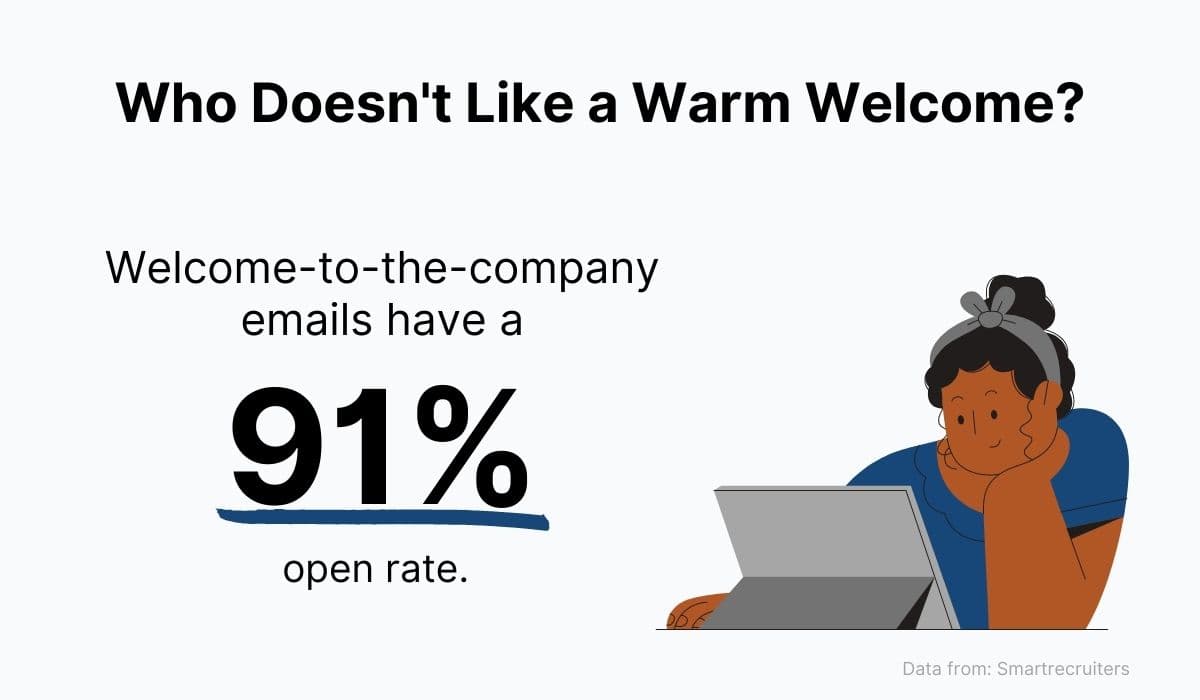
Source: Archbee.com
Creating a welcome email with an eye-catching subject line and a great opening statement should be enough to get the ball rolling.
After all, these are the elements of your email that will attract the new hire’s attention and set the tone for their collaboration with a company they still know very little about.
The best practice to use here is to keep it straightforward and clear, but to also take some steps to engage the new employee and show your fun side.

Source: Smartrecruiters
As you can see in the example above, the subject line is kept short and sweet. It’s really easy to discern what the email is about, and adding the new recruit’s first name and a smiley face are great touches that are sure to make the email stand out.
The same goes for the email’s opening statement. Be concise but cordial, address the employee by their name and extend a warm welcome on behalf of your team.
To go above and beyond, keep the message upbeat and use language that expresses excitement and elation.
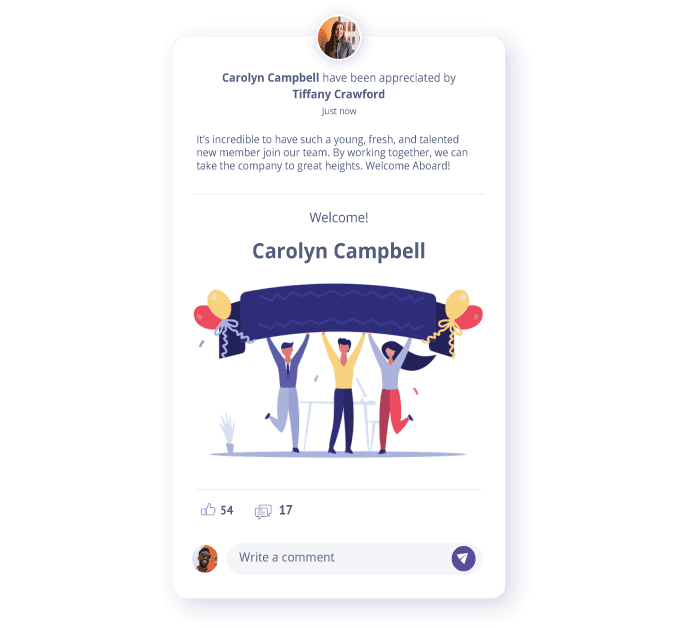
Source: Vantage Circle
Keep in mind that everyone is a bit nervous when joining a new team and starting a new role. Being warm and welcoming is an incredibly effective way to relax them and make the transition so much easier.
Make It Personal
To drive our last point even further, a good rule of thumb to follow is to personalize the welcome message. That’s an easy enough principle to follow, but it will go a long way to make your new employee feel special and wanted at their new company.
Just think of it from your own perspective.
When starting a new job, what kind of message would get you excited and reaffirm your decision to come work for that company?
An impersonal, administrative email containing forms to be filled out and contracts to be signed? Or a warm welcome note that puts you in direct contact with your new superior or colleague?
It’s probably the latter. That’s because a personal touch signals to new employees that they’re going to be valued team members and puts a human face on the company they will be working for.
Besides, there will be plenty of time for the administrative details later.
So, while you’re writing the welcome email, don’t forget to include the person’s name in the greeting. Also, it’s a good idea to mention the new employee’s role and department to make sure your email stays relevant and informative.
But what many managers and team leaders don’t realize is that personalization is a two-way street. In order for your welcome email to truly be personal, you also need to introduce yourself, as well as the team members the new employee will be communicating with.

Source: LinkedIn
In the screenshot above, you can see an excellent example of a personalized welcome email from Buffer, the company that offers the famed social media management tool.
The email addresses the new employee by name several times, but it also introduces the new employee to some very important people—his onboarding buddies.
The email ends on a note of excitement and is signed by the person who sent it (their preferred nickname, no less), giving the new employee a chance to gradually pick up the names and faces of their new teammates.
Another striking feature of this email is how friendly it is, so let’s talk more about that in the next section.
Maintain a Friendly Tone
As we mentioned earlier, taking steps to help the new hire feel more comfortable as they’re about to take on a new role and start working with a lot of new people is of utmost importance.
And an excellent way to do just that is to maintain a friendly, easygoing tone throughout your initial contacts with the new hire.
It might not seem like much, but friendliness and appreciation play a major role in helping new employees adjust. They’re also proven to be important reasons why people choose to stay with their companies.
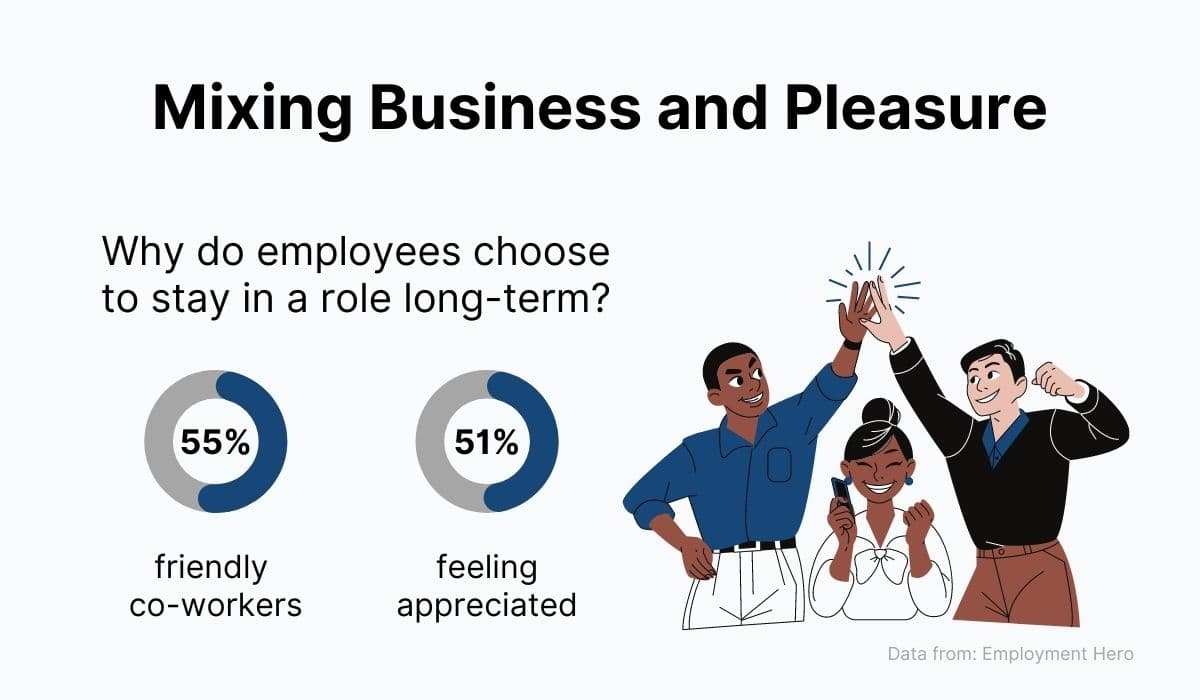
Source: Archbee.com
Therefore, by being friendly from the very beginning, you’re actually doing a lot to secure your new employee’s loyalty in the long run.
So skip the formalities and indulge your fun side when crafting this email. Show your new employee that you’re happy they’ll be joining the team and share some of your company’s culture to make them feel right at home.
A company that does this exceptionally well is Lever, the recruitment software provider. The company delivers the welcome message in the form of a unique, fun GIF that is sure to knock the new recruits off their feet.
The neat part about this is that the whole team participates in its creation, so it’s not just the new employees who get enjoyment out of it.

Source: Lever
The existing team also takes delight in it because they get to do a fun exercise in team building and express themselves in a creative way. In fact, each new iteration of this gif only gets better, more creative, and more choreographed.

Source: Lever
Can you imagine getting something like this in your inbox as you’re getting ready to start a new job? New employees at Lever definitely have much to look forward to as they count down the days to join their new team.
The key takeaway here is that your welcome email is a great place to start sharing what’s fun about your workplace and why you think your new hire will enjoy working with you.
You don’t necessarily need to make an elaborate GIF, but a friendly message from you and your team will definitely work wonders.
Extend a Helping Hand
Before we get carried away with creative GIFs and elaborate choreographies, it’s worth pointing out that your welcome to the team email can also provide some useful information and act as a guide for the employee’s first steps at the company.
Extending a helping hand in this way is actually pretty important because, as you certainly already know, starting a new job can be quite disorienting and confusing for anyone.
A few simple pointers and a couple of resources can be of great help to a new employee trying to get their bearings.
Let’s look at a good example from Nuclino.
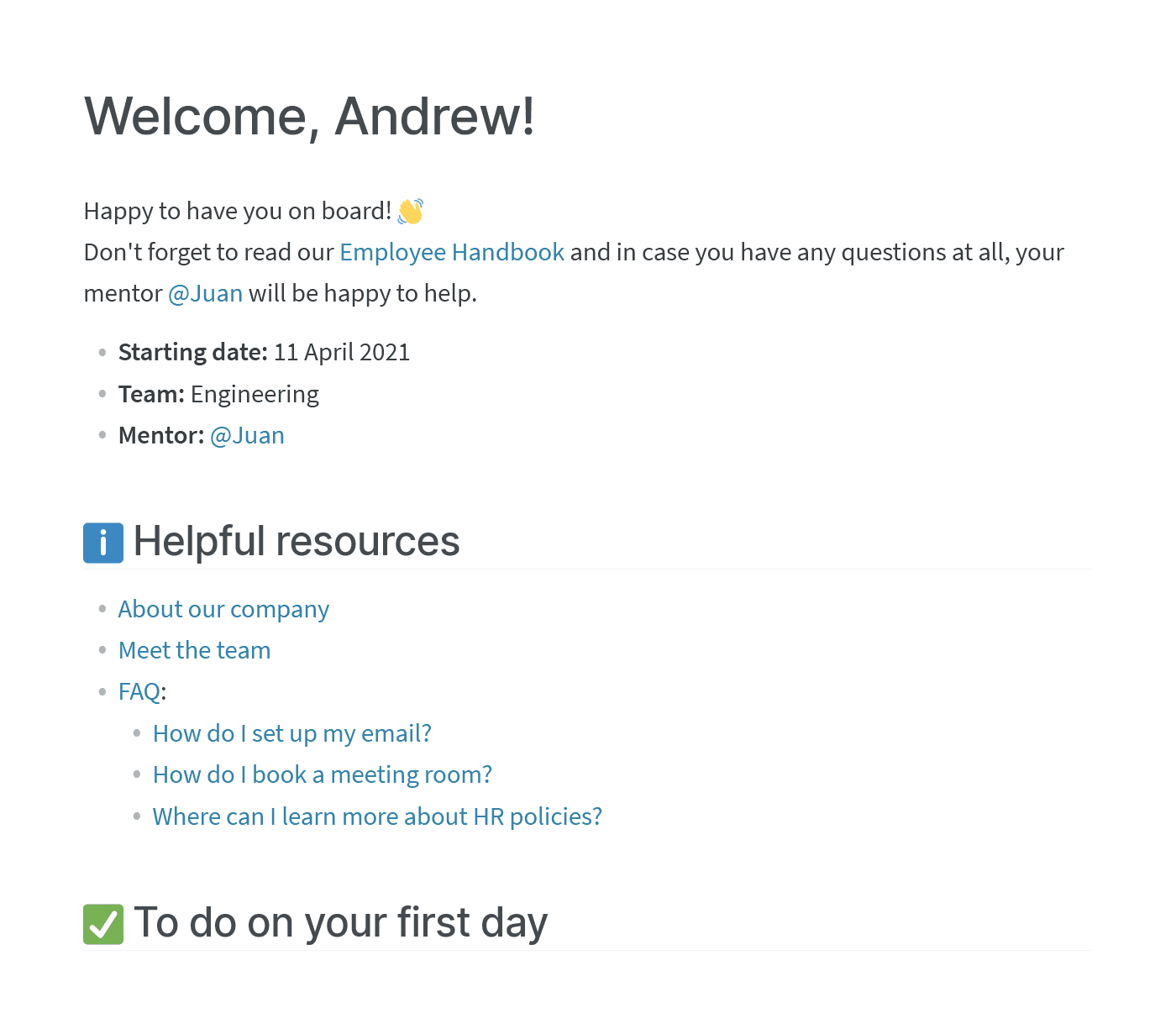
Source: Nuclino
This welcome message includes all the elements we’ve talked about so far, but it also puts the new recruit in touch with their mentor. This is very useful if the employee has any questions they would like answered before they start work.
In addition to that, the message provides a wealth of useful information and resources the employee might want to consult to get more familiar with their new company.
At the very beginning of the message, the new recruit can find a link to the employee handbook, one of the most useful resources for new employees, where the essential information on company policies, codes of conduct, and work processes can be found.
Resources such as the company’s About page, team member profiles, and the FAQ are also included.
All of this useful information can be stored online using quality documentation software, such as Archbee.

Source: Archbee.com
Just think of documentation software as your company’s own, dedicated Wikipedia. It makes all of your knowledge easily searchable and editable.
Most importantly, it allows you to share the key documents, such as the aforementioned employee handbook, faster than you can send a cat meme to your favorite work buddy.
So if you’re only using your welcome email as a professional courtesy, we hope this section has convinced you that there’s so much more you can do with it.
The next time you’re welcoming your employee, try to enrich your email with some helpful resources to help them prepare for what’s ahead.
Deliver Some Pep Talk
To reiterate our previous point, people commonly feel quite nervous and anxious as their first day of work at a new company draws nearer. Extending a helping hand can do wonders to help them feel more comfortable, but it may not be enough.
For your welcome email to truly cement the new employee’s decision to come work with you and motivate them to do their best work from day one, you’re going to have to show some true leadership and deliver a good pep talk.
And just like with friendliness and appreciation, motivating employees early on can have a powerful effect on their performance and willingness to stay with the company in the long run.
In fact, a manager's ability to motivate and inspire is becoming a core trait in today’s corporate world, where worker engagement is at an all-time low.

Source: Archbee.com
But don’t worry; motivating a new employee and delivering a good pep talk won’t take much effort or time at this stage. All that’s needed is a few well-chosen words that will reassure the employee and take some of the pressure off.
For example, it will probably suffice to say that you believe the new employee will make an excellent addition to the team and that no one expects them to perform perfectly on their first day.
That being said, some companies go the extra mile when it comes to generating enthusiasm in their employees ahead of their starting day.
A good example of that is Apple, which tries its best to inspire employees to try their hardest and take ownership of their work from day one.

Source: Instagram
Whether you go big or small, just keep in mind that a few kind words are all that’s needed to put someone’s mind at ease in most cases. It’s an almost effortless thing to do, but your faith and kindness can resonate with your new employee for a long, long time.
Set the Stage for a Great First Day
Speaking of the many functions of your welcome email, another notable one is that it can go a long way to ensure that your new employee has a great first day at work.
If you don’t see the importance of that right off the bat, remember that a first impression is a very powerful thing.
If an employee comes to work on their first day and spends it sitting around and feeling useless, they’re going to form an opinion about their new workplace that won’t be easily erased.
On the other hand, if an employee comes into work prepared for everything that comes their way, if they know exactly where they should go and what’s expected of them, they’ll have a first full first day that is rich with new experiences.
Most importantly, their positive image of the company will further reaffirm their desire to stay in their role in the long term.
Reading this, you probably already have a few ideas on what kind of useful information to include in your welcome email.
Nevertheless, here are some ideas to get you on the right track:
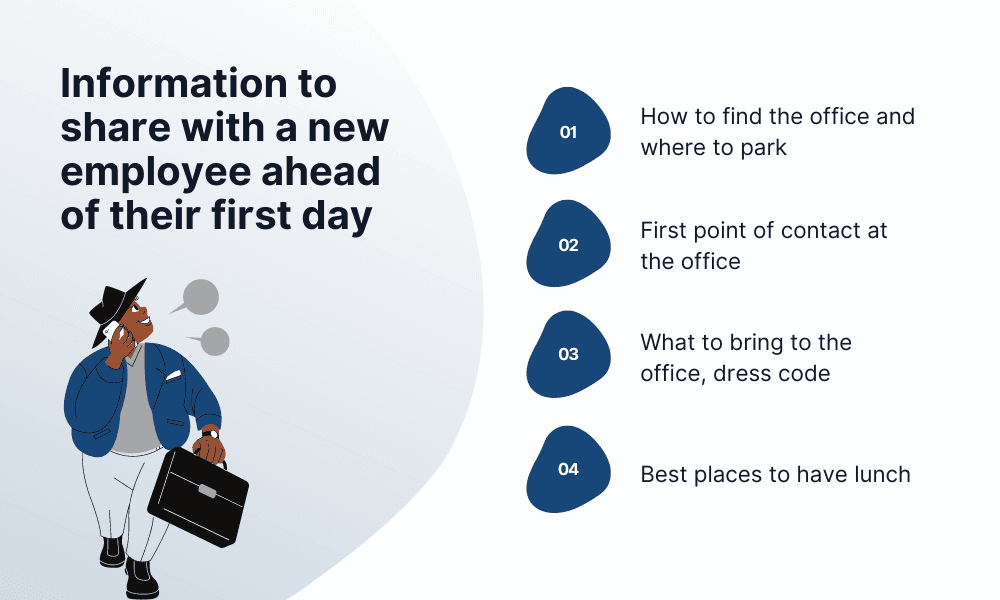
Source: Archbee.com
Your tips and insider advice will, of course, depend on the specifics of your company and the kind of work you do. The main thing is to include everything you feel might help the new employee settle in and start working without a hiccup.
Let’s look at a real-life example.

Source: Medium
A great detail to note here is that the new employee knows they will be supported from the second they step foot in the office.
Someone will greet them at reception and show them to their workspace, they already have plans for lunch, as well as a couple of tasks to be completed on their first day.
Remember, new employees won’t automatically know what to do as soon as they start working. It’s up to you to support them until they become independent.
A great way to start doing that is to make sure the information in your welcome email keeps them busy and engaged from the very beginning.
Encourage Them to Reach Out With Any Concerns
As you’re bringing the welcome email to a close, it’s always a good idea to make sure that the lines of communication remain open and that the new employee has a place to turn to with any questions and concerns.
We’ve said it before, but it’s worth repeating that there’s a lot of uncertainty tied to starting a new job.
What’s more, new employees are often nervous about asking too many questions because they’re afraid they’ll say something that might negatively impact your opinion of them.
This is especially true with introverted employees who actually make up a large portion of the workforce.

Source: Archbee.com
And that can become a real problem. Employees who aren’t encouraged to speak up and ask questions are at risk of falling behind because their progress is slower than that of their peers who are inquisitive and confident enough to voice their opinions and concerns.
That’s why it’s so important for managers to actively seek out feedback and encourage discussion at every opportunity.
It’s also why it’s a good practice to end your emails with a note reminding the employee they can contact you with questions and concerns if they need to.
The welcome email is no exception here. Just look up any welcome-to-the-company email template, and you’re sure to find a short section encouraging the new employee to get in touch.
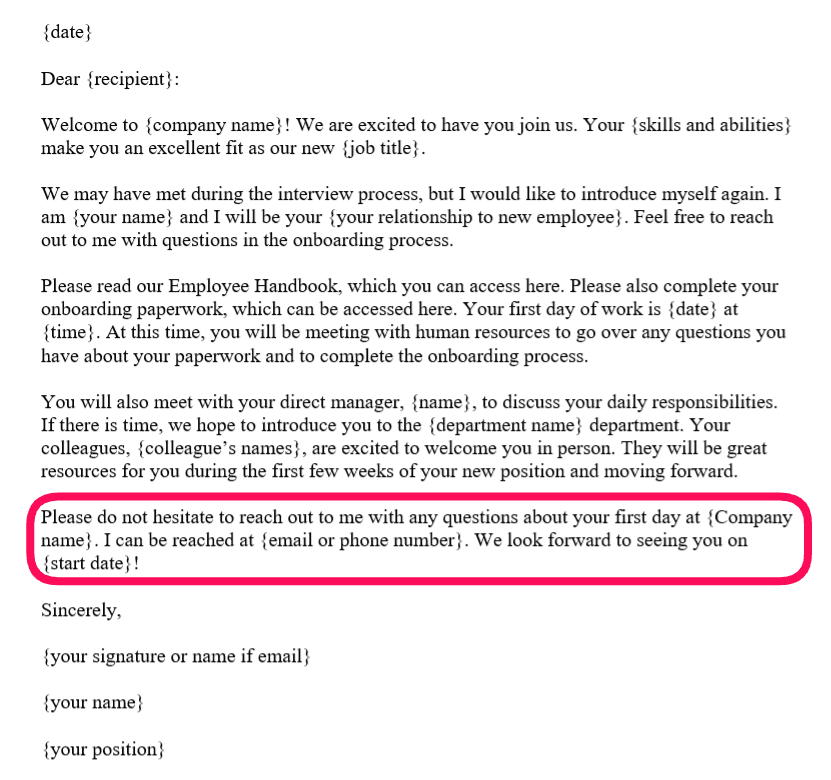
Source: Sample Notes
And that’s it! All that’s left is a polite sign-off and your signature, and you can send out your perfectly crafted, amazingly informative welcome email to your new recruit.
Conclusion
In this post, we’ve broken down the basic elements of an encouraging, polite, and, above all else, informative welcome-to-the-team email and explained the importance of each one.
If you stick to the simple process outlined above, you’re sure to energize and motivate your new employees ahead of their first day, as well as eliminate a lot of the anxiety they might be feeling starting a new job.
FAQ
Frequently Asked Questions
A welcome email for new employees is used to kickstart their integration into the company. It's a chance to make them feel valued and excited about their new job, provide useful information and resources, and set the tone for their relationship with the company.



